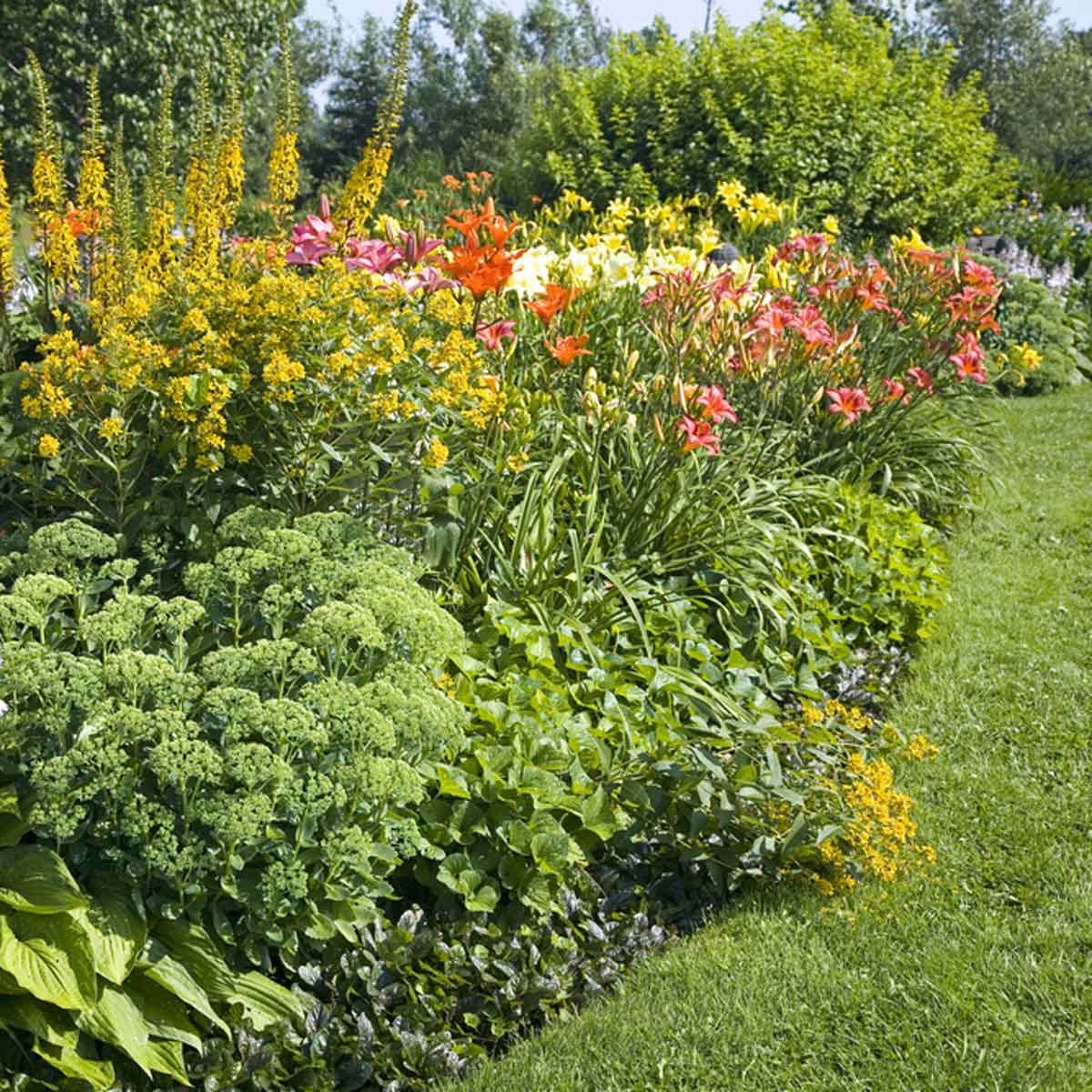Table Of Content

In terms of color, I consider both the bloom and foliage hues to cultivate a harmonious palette that complements the surrounding landscape. Adding different textures and forms adds visual interest and movement to the flower bed. I incorporate a blend of perennials for consistency and annuals for splashes of seasonal color, ensuring a captivating display throughout the growing season. Before grabbing your gardening tools, take some time to plan your flower bed design. Take note of the amount of sunlight it receives and the soil conditions. Research different flower species and their specific requirements, such as height, color, and blooming season.

Flower Bed Ideas and Designs
In these areas, go ahead and turn over the soil to incorporate the organic matter and then plant. The first step when planning to add a new flower bed or even if you are simply planting a tree or shrub is to check if there are any buried utility lines on your property. Most areas should have a number you can call to check locations for these lines.
CREATING THE BEST SOIL FOR FLOWER BEDS
5 garden drainage ideas to help prevent flooding - Homes & Gardens
5 garden drainage ideas to help prevent flooding .
Posted: Fri, 22 Dec 2023 08:00:00 GMT [source]
Not only are they less strenuous on your back, but they also allow you to control your soil composition and provide protection from weeds. You can fill them with the same flowers you would an in-ground bed. Make a homegrown bouquet with flowers from your very own garden. "A cut-flower garden bed enhances the beauty of your outdoor space and allows you to enjoy freshly cut blooms indoors," says Laura Walsh of Oasis Forage Products.
Practical Aspects of Gardening
Experiment with different configurations, taking into account plant heights, the mature size of the plant, color combinations, and any focal points you want to incorporate. A well-designed layout will ensure that your garden looks balanced and harmonious. Are you looking to attract pollinators, butterflies, or provide cut flowers? Understanding the purpose of your garden beds will help your direction. However, river rocks do not add organic matter to the soil over time, and they do not conserve moisture well.
Remove the Grass
A tried-and-true method for preventing weeds is installing landscape fabric between your garden's soil and the mulch. "When it's time to add plants to the garden, holes can be cut in the material to suit the plant's size," says Putnam. With that being said, you may want to choose a location that gets some afternoon shade, as it can protect your blooms from extreme heat during warmer months.
I'm Mahedi Hasan, an agricultural expert and Chief Officer at C.P Group, Thailand. I've launched Foliar Garden, a free platform sharing insights on indoor plants, gardening, nutrients, and breeding. Spread your mulch and compost on the surface, and turn it into the soil gently.
Prepare the Soil
If you take this approach, start by choosing a design for your raised bed—you can DIY one or go with ready-made containers. "When designing a DIY raised bed, try to keep the width under 4 feet for access to plantings in the center," says Putnam. Fill the bed with soil specifically labeled for a raised bed garden and plant your flowers the same way you would for an in-ground bed. If you want to enhance your home's curb appeal or add seasonal interest to your backyard, a flower garden is the perfect solution. In my gardens, layering is about more than just height; it’s about creating depth with textures and forms.
I also keep in mind the blooming periods of plants to ensure a consistent display of color. When arranging a flower bed, choosing the right color palette can transform the look and feel of your garden. I’ll guide you through understanding color theory and selecting the perfect colors to ensure your garden pops with vibrancy. Remember to consider the specific requirements of the plants you're growing, as planting techniques can vary depending on the plant species. It's also essential to choose appropriate planting times based on your local climate and growing season.
Gardening & Landscaping Ideas - Southern Living
Gardening & Landscaping Ideas.
Posted: Thu, 01 Jun 2023 20:43:23 GMT [source]
Containers for Added Color
You’ll only need one of the two, and there’s no way you’ll need more than five pounds per hundred square feet to make things right. The first is that it keeps grass roots out of your garden, and the second is that it helps prevent the nutrient-rich soil from your garden from getting out into the lawn. You can install physical barrier edging or maintain a trench edge with a mechanical tool. Welcome wildlife, like bees, butterflies, and hummingbirds to your garden by planting pollinator-friendly plants, including bee balm, butterfly bush, asters, and more. "Pollinators contribute to the overall health of your local ecosystem and foster biodiversity," says Spoonemore. You’re looking for a soil consistency that balls in the hands but breaks apart easily if you give it a gentle tap with a gardening trowel.
Keep the area covered for up to a year before planting for best results. Most flowering annuals and perennials appreciate loamy soil with plenty of compost added to it. Make sure to rake away rocks or other debris from the site, break up large clods of dirt, and add compost to enrich the bed and encourage healthy plant growth. It's also a good idea to do a soil test to determine if you should add any nutrients your plants need to look their best. After turning this compost into the soil, you may want to put another layer on top of the soil to act as mulch. If you add organic matter in the fall, it isn't necessary to add more in the spring.
The second type of bed is an existing bed that has nothing in it. In other words, you are replanting the same area you used last year. With this type of bed, you can treat it similarly to the brand new bed, but it shouldn't be necessary to layer the newspapers to kill existing vegetation. If you are a beginning gardener, properly preparing your soil can be daunting. However, there are some easy steps that you can take to get your beds ready to be planted.
In this article, we will discuss how to design a perennial flower bed and provide ready-made schemes for inspiration. I was blown away when I used the Garden Planner to tweak my pollinator bed, a mixture of established perennials and seasonal annuals in a highly visible spot. Having recently removed several perennials the deer liked more than I did, the Planner helped me find the right spaces for new animal-resistant flowers I want to grow.
A garden hose can be moved and reshaped until you find exactly the right shape and size for your bed. The roots of a plant are the foundation on which that plant thrives. Good roots will generally mean that you have a happy, healthy plant that can survive the rigors of spring and summer.
Island beds, on the other hand, are not anchored by a backdrop and can be viewed from all sides. Center anchors can be anything from a tree, shrub or large perennial to a piece of statuary or a large container, even a bench or trellis/arbor can work as a center anchor. A flower border is generally, but not always, long and narrow. How deep your bed needs to be will partially depend on how long the bed is. A short bed doesn't need to be as deep, a 3 foot by 8 foot bed will look right at home. You may also be asking where you can get compost or organic matter.
This might seem daunting, but with some planning, preparation, and sweat equity, you'll soon enjoy a more beautiful, flower-filled garden. The photo on the left is from the Ball Seed Company garden in West Chicago, Illinois and shows, more or less, a wildflower meadow. The center photo is from the Boerner Botanic Garden and shows a curving walkway bordered by colorful plantings.
"It encourages regular pruning, which promotes healthier growth and more abundant flowering." Even better? Cut flowers straight from your garden last longer than store-bought ones. To manage weeds, I apply mulch and use landscape fabric to suppress weed growth without chemicals.

No comments:
Post a Comment